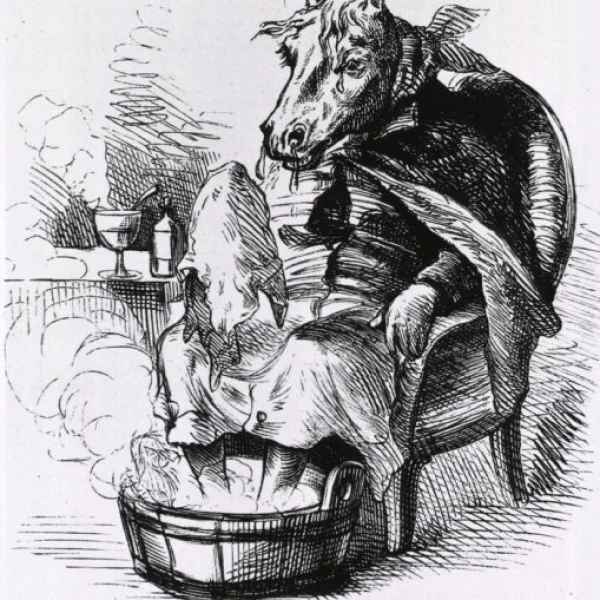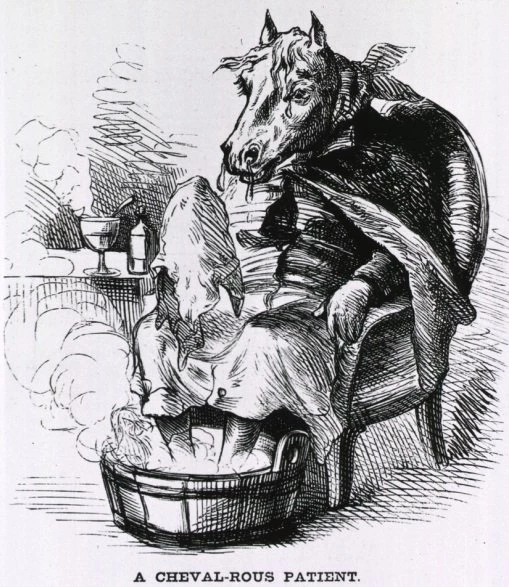Bloomington’s streets were eerily quiet for several weeks in late November and early December 1872. Missing from the normally bustling downtown and surrounding neighborhoods were horses, and in the age before the internal combustion engine and the automobile, it was difficult to get from here to there without flesh-and-blood horsepower.
The Great Epizootic, which had already ravaged the East Coast and major inland cities such as Chicago, had reached Bloomington. Nearly every horse, mule or donkey for miles around was sick or dying, relegated to barn or stable until the highly communicable strain of equine influenza burned through the area.
Until it was over, it was difficult to shuttle passengers and goods from railroad depot to factory, store or home, since omnibus and dray lines (respectively, taxis and delivery trucks of the day) had no healthy animals. Public transportation also came to a halt, given that horses in Bloomington-Normal and hundreds of other communities were needed to pull street railway cars (this was before the electric era).
The equine influenza was known as the horse flu or, more popularly, the horse epizootic (a word for a non-human epidemic). It is spread among horses, and exposure to manure and urine in tight quarters common in 19th century stables made for an ideal environment of widespread exposure. Symptoms included a fever, cough and heavy mucus discharge from the nose and mouth. For several days or more, infected horses would be listless, with heads cast down and little interest in either food or water, unable to pull or carry loads.
The 1872 North America epizootic was the largest recorded outbreak of its kind in history.
The first case appeared outside of Toronto, Canada in late September. By Oct. 10 it had crossed the international border and reached Detroit. The epizootic then swept through the U.S., eventually reaching Cuba, Mexico and even into Central America. It was still sweeping through Arizona Territory settlements as late as March 1873.
The percentage of horses infected in the continental U.S. is placed anywhere from 80 percent to the high 90s. Mortality rates were highest in urban environments, reaching 10 percent in some cities, though more often than not the 1872 outbreak killed between 1 and 2 percent of the horse population in any given community.
By Nov. 12, Bloomington’s anxious residents were all abuzz with talk of the looming epizootic then raging on the East Coast. “‘Has it come?’ ‘Have you got it?’ ‘How are your horses?’ These are the common salutations nowadays,” related The Pantagraph. The Daily Leader, a long-defunct Bloomington newspaper, advised area residents to brace for the worst and “lay in a good supply of fuel; and otherwise prepare to get along without the aid of horses.”
The equine scourge reached Bloomington the third full week of November. The Leader reported on Nov. 22 that nearly all the horses in the downtown Ashley House stable had a “suspicious cough.” There were other ominous signs as well. “One of General [Asahel] Gridley’s horses is down, and is pronounced a clear case,” added the paper. “Dr. [Asa P.] Tenney, also, has a horse that is not expected to live.”
The Pantagraph agreed with its competitor that the epizootic was here. “It is now estimated that about 200 horses have been attacked in this city within three days,” announced the paper’s Nov. 23 edition.
Oxen, unaffected by the epizootic, were drafted into service. Accordingly, The Leader announced that “the gentle ox had made his appearance on our streets,” with a team of the burly beasts pulling a coal wagon. Once common during the early pioneer era, many of Bloomington’s younger residents marveled at the “singular sight … as though it was a team of elephants or camels.” Concluded The Leader: “Though not much for pretty, the ox is surefooted, and good for pull, and, above all, can bid deviance to the dreaded epizootic.”
During these two long weeks human muscle also supplanted horsepower. “Many of the grocery merchants are delivering groceries with wheelbarrows and handcarts,” reported The Leader, adding that “in some instances wagons are hauled through the streets by men.” Marion Chuse, chief engineer of the Bloomington Fire Department, announced that horses of engine company No. 1 were out of commission, and in the event of a fire, he called for volunteers to “man the ropes.”
By Nov. 26, the epizootic had spread to every corner of Bloomington, with The Pantagraph noting that “scarcely a horse in the city is free of it entirely.” The few horses still able to work were seen “blanketed and bandaged” on the city’s tranquil streets and alleyways. “Many ludicrous scenes occur during the day,” it was noted, “such as toting the mails to and from the depots by handcart.”
The influenza was also called a horse “catarrh,” a term especially popular in the 19th century for inflammation of mucous membrane and congestion and soreness of the nose and throat. A panoply of dubious patent medicines and harsh treatments promised to cure equine influenza. Many so-called remedies, such as bloodletting, purging, drenching and blistering, did more harm than good. The Pantagraph, to its credit, ran an editorial urging “humane and common-sense” care centered on things like rest.
Influenza’s grip on the local horse population began to loosen in early December. Street railway service was up and running by Dec. 7, and once again the horse enjoyed dominion over Bloomington’s thoroughfares. Thankfully, local fatalities were rare, probably numbering no more than a few dozen in the city.
During the early days of the outbreak, the Leader commented on the prospect of life—if only for a week or two—without horses. “The people of this city,” the paper stated, “will have an opportunity to learn the real value of the noble horse, and how much we are all dependent upon ‘man’s best friend’ among the brute creation for comfort and convenience.”
During the height of the local outbreak, The Pantagraph ran a humorously resigned poem about the epizootic titled “Hors De Combat” This poem, which appeared earlier in the Boston Commercial Bulletin, begins and ends with these stanzas:
Upon my sole I’ve walked so much,
Since horses have been hoarse,
I feel like some pedestrian sport
In training on the course.
Then let us hope that horses may
Be freed from all their woes,
And running on their feet again,
Instead of at the nose.

